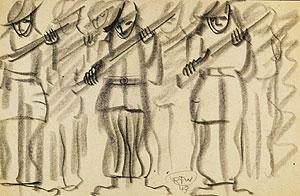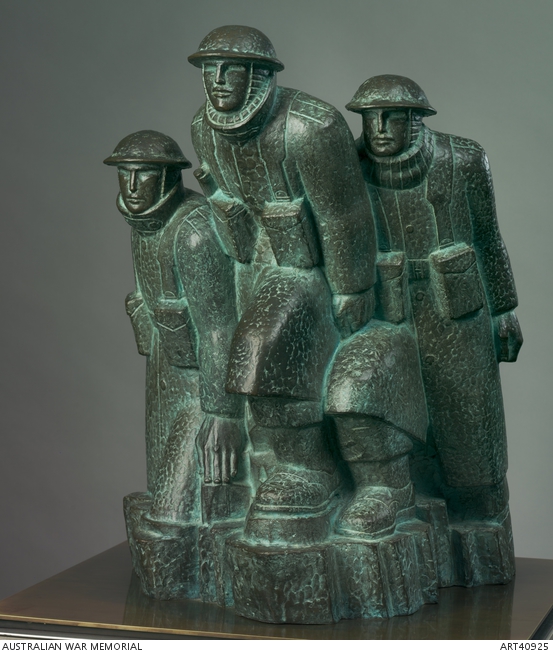Shaping Memory: Sculpture at the Australian War Memorial
- Shaping memory
- First World War
- Second World War
- Post-war responses
- Memorials
- Future directions
- Medallions
Second World War: changing forms
The sculptures in the Second World War collection reflect the inevitable stylistic influences of modernism, though the ties to traditional figurative style endured. The official war art program, established for painters to document the First World War, now included sculptors for the first time. Their work displays a range of styles, typical of the many different but concurrent artistic practices within Australia at that time. Lyndon Dadswell, and George Allen were the first to break away from the more conservative style that had predominated in the First World War. Ray Ewers and Ralph Walker worked on dioramas but their main interest lay in figurative sculpture, in which they pursued more nuanced expression.
The collection was further enriched by the inclusion of diverse works by European artists who had been interned in Australia during the war. The ideas of the Bauhaus and Vienna schools came through in the work of the artists Karl Duldig and Ludwig Hirshfeld Mack.
George Allen covered the New Guinea campaigns and was the only Second World War official war artist to work in stone. This posed particular challenges for the artist, especially in his choice of subjects:
I am afraid none of my pieces of sculpture are illustrations of a particular incident; rather, they are the culmination of a number of observations. I therefore find it difficult to give any exact time and place ...
The native carrier was a familiar sight in New Guinea. At times, he was the troops’ life-line. Trudging these nightmare ranges day after day, single file, his burden carried shoulder high, the New Guinea native carrier made an impressive sight. They transported ammunition, mortar bombs, rations, oil. My sculpture represents a native bearing a tin of rations.
Ewers was appointed a war sculptor in 1943, and worked mainly in New Guinea. His work is represented in the Memorial by several small bronzes, large bronze figures in the cloisters and the grounds, and the small diorama series entitled Transportation of supplies, Owen Stanleys, 1942, as well as the Tobruk and Tarakan dioramas.
Ship bearing red ten was commissioned in 1967, at the suggestion of the sculptor, for the new extensions to the main building at the Memorial. Adams was a Cape Horner whose experiences at sea inspired him to create this work:
It is based on an officer-of-the-watch at a standard compass, a subject which [I] often saw at sea and in which [I am] attempting to get the feeling of tension which usually occurred when a strange ship appeared particularly at dawn and dusk. The men on the bridge or the compass platform assumed an air of mystery as they moved about.
Adams was commissioned to represent the activities of the Australian and US navies and the Merchant Marines in the South Pacific, and also worked in Britain, Rabaul and Japan.

Ralph Walker
Japanese engineer
As none of the official artists have recorded the Greek campaign I have based most of my work along those lines. Greece represents the 16th Australian Infantry Brigade during its march back over Mt Olympus. Straining, climbing, exhausted, half-frozen soldiers. Owing to complete absence of roads, lack of unit transport, intense cold and great distances covered, this movement stands high as a feat of disciplined endurance.
Dadswell trained as a sculptor in Sydney under Rayner Hoff and in Melbourne with Paul Montford, sculpting 12 panels for Melbourne’s Shrine of Remembrance. He enlisted in 1940 and served with the 2/3rd Battalion in the Middle East.
After being badly wounded in the Syrian Campaign, he was relieved of combatant duties and appointed a war sculptor, sharing studio facilities with Ivor Hele, and assisted briefly by John Dowie, in Cairo. In the immediate post-war years, as a teacher in Sydney, he played an important role in awakening public and official interest in modern sculpture.
He was very keen on the Swedish sculptor Carl Milles and the rather pneumatic work of the Englishman Frank Dobson, and this showed in his own work. Lyn considered that modeling was a building up process and that it was aesthetically false to use it in any other way. (John Dowie)
Fatigue drew on Ralph Walker’s experiences at Kapooka, which he described as a place of endless tedium. Walker met the artists Sali Herman and James Cant at the camp, where they initiated young groups of bored young men into the art of concealment. So successfully that sometimes complete squads, with attendant NCOs, would disappear from the eyes of higher authority.
Walker’s talent for the keen observation of people, regardless of race or situation, and his finely wrought ability to capture the essential form of his subjects, produced a stunning series of portraits for the Memorial. Taken together, they convey a sense of the personal, inner qualities of the individual, caught up in the greater sweep of war.
This chap came from an area in New Britain [Arawe] where the skull is bound in infancy to produce this peculiar elongated effect.

Ralph Walker
Soldiers presenting arms








